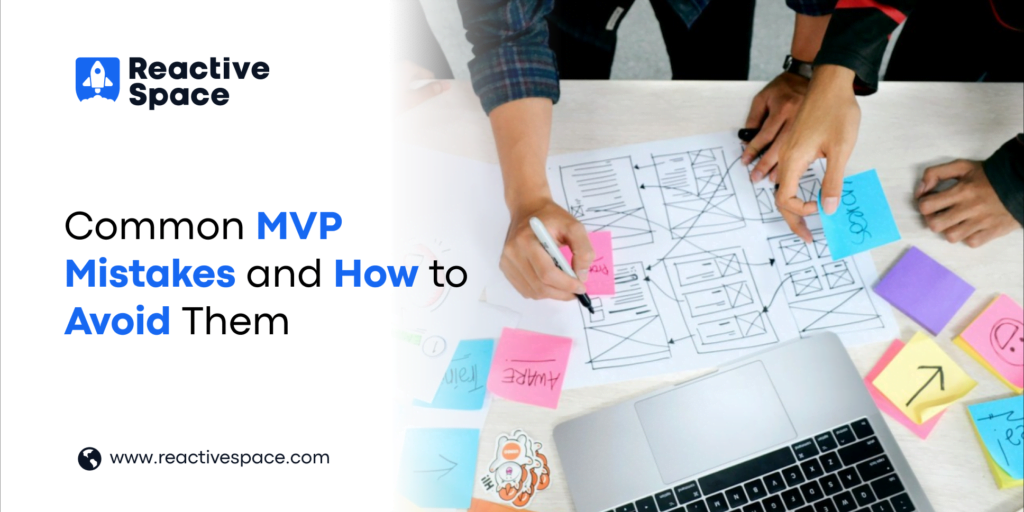
Starting to develop a Minimum Viable Product (MVP) is an exciting phase for startups. It’s when ideas become real products for testing the product in the market. But it’s easy to make mistakes that can mess up your project. We’re here to help you avoid these common mistakes and keep your project on track.
What is an MVP?
Before we find the reason for failing MVP in so many companies, first we must understand the MVP. The initial version of a product with just enough features to capture the attention of its target users and validate the idea is called MVP. An MVP should offer sufficient value to early adopters, encouraging them to continue using it over the long term. Having an MVP allows your users to test the product, gain their feedback, and figure out whether it has the potential to be a successful business before you create its full version.
Why is an MVP important?
An MVP (Minimum Viable Product) is a game-changer for startups, offering multiple advantages. By launching a basic version of their product, startups can:
- Validate their ideas with less investment, testing market demand and gathering real-user feedback
- Decrease risks by focusing on core features, minimizing costs, and avoiding unnecessary development
- Get to market faster, enabling an iterative development process and continuous learning
- Efficiently allocate resources by prioritizing only the most critical features
An MVP is a strategic tool for startups to create their ideas, remove risks, accelerate time-to-market, and optimize resource allocation in the early stages of product development. With the help of an MVP approach, startups can set themselves up for success and lay the foundation for a thriving business.
What are the Common mistakes while building an MVP?
As we identified the importance of minimum viable product development for businesses, let’s look at some of the most common mistakes made by MVP startup companies, and make sure you don’t repeat them.
- Poor product strategy
- Feature overload
- An over-engineered MVP
- An oversized development teams
- Too much feedback
Poor product strategy:
Product strategy is the engine of the business. It’s the mechanism, designed to turn your invested resources into working outcomes. You will not be able to establish a business if your strategy is not strong.
Running out of cash is the biggest worry for new entrepreneurs, and a weak MVP development strategy is even more dangerous.
If you can prove that your product works, even though it’s not breaking any world records just yet, you’re likely to raise more capital if you need to do so. However, things start to get more complicated when the MVP strategy is falling behind.
Some of the potential risks of following a poor product strategy include:
- Keeping your team busy rather than productive.
- Failing to maintain client engagement and retention.
- Burning your budget on marketing, scaling sales prematurely, and not generating satisfactory results.
- Running out of funding.
Feature overload:
Achieving market success with your product is like climbing up a mountain. You can use various technologies and target different audiences to meet your business objective. When it comes to building an MVP, feature overload translates directly into:
- Delaying the delivery of the first version of your product,
- Having to rework product modules that failed to provide value to your clients,
- Running out of budget faster and not meeting your targets.
An over-engineered MVP:
Keep in mind that you don’t need to address every user’s need at the first stage of business. Prioritize core functionality and focus on the actions that will be valuable in the long run.
Overengineering your MVP can have severe consequences, including:
- Wasting resources on custom design and manual architecture setup instead of leveraging frontend frameworks.
- Spending too much time on details in the early stage.
- Generating unnecessary code that won’t be useful in future product versions.
- Delaying the deployment of your MVP.
- Use extra efforts on perfecting the final solution instead of gathering crucial client feedback
An oversized development team:
Having too many experts on board at the start can harm your project’s long-term success.
An oversized team can lead to:
- Slower development, lower performance, and poor team morale due to lack of work
- Wasting budget on non-essential tasks and keeping planners busy with non-revenue-generating work
- A weak product strategy
It’s important to balance expertise with team size to ensure project success.
Too much feedback:
Too much feedback can be overwhelming when starting a business. Be selective about who you listen to and what you implement at the MVP stage. Focus on your main goal and fulfill the needs of your target audience’s needs.
Implementing too much feedback can lead to:
- Delays and slower development.
- Constant rework.
- Losing focus on the core goal.
- Budget wasting.
- Wasting the talent of your resources and demotivating the team.
How to avoid mistakes in MVP development?
To avoid mistakes in MVP development, it’s important to define your goals clearly and validate your idea through user feedback. Prioritise core features and keep your MVP simple, flexible, and easy to iterate. Avoid over-engineering and overinvesting in a single feature or technology. Focus on agile development and iterative improvement, releasing your MVP to a small group and enhancing it based on user feedback. Monitor user feedback regularly and stay focused on your core objectives. Most importantly, learn from failure to improve and be willing to adjust your approach as needed. To minimize mistakes and maximize the chances of success for your MVP development be more conscious.
Avoiding common mistakes in MVP (Minimum Viable Product) development is crucial for startups and entrepreneurs to successfully generate their ideas and bring the products to market. By defining clear objectives, prioritizing features, gathering user feedback, iterating based on feedback, setting realistic timelines and budgets, and involving stakeholders throughout the development process, startups can minimize the risk and increase their chances of creating a successful MVP. With the help of these strategies, startups can navigate the MVP development process more effectively and increase their chances of creating a product that meets user needs and achieves business objectives.



